The towering Grade II-listed chimney, a relic of a bygone industrial era, stands as a testament to the region’s manufacturing heritage. Its imposing structure, once a symbol of bustling productivity, now presents a unique opportunity for innovative redevelopment. Auctioneers, recognizing the potential hidden within these brick and mortar giants, have proposed a compelling vision: transforming the chimney into a truly distinctive dwelling or workspace. This concept, while seemingly unconventional, caters to a growing demand for unique and character-filled properties, offering a chance to inhabit a piece of history while simultaneously contributing to its preservation. The challenge lies in balancing the preservation of its historical significance with the demands of modern living or working, a delicate act of architectural adaptation that requires both creativity and respect.
The allure of converting a historic chimney into a living or working space lies in its inherent individuality. It offers a stark contrast to the homogeneity of modern architecture, providing a dwelling or office steeped in narrative and industrial aesthetic. Imagine a multi-level apartment spiraling upwards within the chimney’s circular confines, each floor offering panoramic views of the surrounding landscape. Picture a minimalist office space, the raw brickwork and industrial elements juxtaposed with sleek, contemporary furniture. The possibilities are as vast as the chimney itself, limited only by the imagination and the practicalities of structural engineering. This type of adaptive reuse not only breathes new life into obsolete structures, preventing their decay and demolition, but also adds a unique and compelling dimension to the architectural landscape, fostering a sense of place and connection to the past.
However, undertaking such a project presents a complex array of challenges. The cylindrical shape of the chimney poses inherent limitations on space utilization and layout design. Integrating modern amenities like plumbing, electricity, and HVAC systems within the existing structure requires meticulous planning and skillful execution. Moreover, preserving the historical integrity of the chimney while adapting it for contemporary use demands a careful balance. Architects must navigate the intricacies of building codes and regulations while respecting the heritage value of the structure. The process necessitates a sensitive approach, blending modern functionality with historical preservation to create a harmonious and sustainable outcome.
Furthermore, the cost of such a conversion can be substantial. Reinforcing the chimney’s structure, installing utilities, and addressing potential environmental concerns, such as asbestos removal, can significantly inflate the budget. The unique nature of the project also requires specialized expertise, both in architectural design and construction, adding to the overall expense. Despite these financial hurdles, the potential return on investment can be significant. The scarcity and desirability of such unique properties often command premium prices, making the conversion a potentially lucrative undertaking for the right investor. The combination of historical significance, architectural intrigue, and limited availability creates a compelling proposition for discerning buyers or businesses seeking a one-of-a-kind space.
Beyond the financial considerations, the conversion of a historic chimney into a habitable or usable space carries significant cultural and environmental benefits. It contributes to the preservation of industrial heritage, transforming a symbol of past industry into a vibrant part of the contemporary landscape. This adaptive reuse prevents demolition and the associated waste, promoting sustainability and reducing the environmental impact of new construction. Furthermore, these unique conversions often become local landmarks, attracting tourism and contributing to the cultural richness of the community. They serve as a reminder of the region’s industrial past, sparking conversations about history, architecture, and the evolving relationship between humans and the built environment.
In conclusion, the proposition of transforming a Grade II-listed chimney into a “quirky home or office” presents a unique opportunity at the intersection of history, architecture, and sustainability. While the challenges are undeniable – from the complexities of structural adaptation to the substantial financial investment – the potential rewards are equally compelling. The resulting space offers not just a dwelling or office, but a unique piece of history, a testament to human ingenuity and the enduring power of adaptive reuse. These projects contribute to the preservation of our industrial heritage, promote sustainable development, and enrich the cultural fabric of our communities, demonstrating that the seemingly obsolete can be reimagined and revitalized for a new era. They serve as a powerful example of how creative vision, coupled with meticulous planning and execution, can transform remnants of the past into vibrant spaces for the future.














